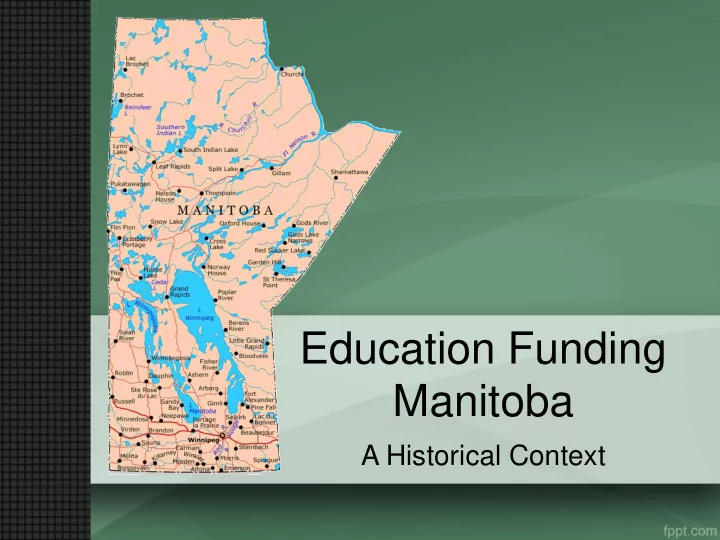

Education Funding Manitoba A Historical Context
CBC News Review has potential to 'completely change the way education is funded in Manitoba': NDP Funding and school division amalgamation will be considered in Tory review, education minister says
Intentions of Discussion To create a strong dialogue and discussion about principles of an equitable provincial funding model by: • Providing a historical view of provincial funding in Manitoba and what has gotten us to this point • Looking at changes to the funding model over the past ten years: Equalization, TIG, Zero Guarantee • Examining Categorical Funding Changes • Providing opportunities for MASS members to discuss implications of potential funding formula revisions
Principles of Funding Model • Enrolment as prime driver of funding formula • Small Categorical Grants to place emphasis on a number of areas • Local taxation authority to provide local autonomy • Equalization support to offset differences in local property tax assessment base
Base & Categorical Funding • Base Funding – General per student • Categorical – two types: – General Funding – Transportation, Student Services, Enrolment Change – Targeted Funding – EAL, Early Childhood, Literacy & Numeracy, Aboriginal Academic Achievement, etc
General Categorical • Primarily has gone unchanged in past ten years. • Ex. Transportation Categorical Grant provincially funded 62% of Transportation Costs – Today 51%
A Historical View
Current View
Equalization - Facts • A formula that provides additional revenue to school divisions that have lower tax assessment bases • Calculated by taking the average assessment per pupil divided by the average of the highest school division assessment per pupil rate • The equalization factor is multiplied by 66% of the total Unsupported expenses
Equalization Facts • In 2005-2006 Equalizations Support was 14.1% of total provincial funding • In 2015-2016 Equalization Support was 24.9% of total provincial funding • Equalization has gradually been increased from 60% to 66% over the past ten years
Tax Incentive Grant Introduced in 2008 -2009 2008 - 2009 • 17 school divisions received the TIG • Represented 5.3 million dollars or 0.6% of total provincial funding 2011 – 2012 (last year of TIG) 61.4 million dollars or 6.3% of total provincial funding 2016-2017 • 34 school divisions received the TIG • Represented 61.4 million dollars or 5.8% of total provincial funding
Guarantee • 2003/2004 Amalgamating School Division Guarantee introduced 2% Guarantee • 2008-2009, 2.4 million dollars was provided to 11 school divisions or .3% of total provincial funding • 2009-2010, 4.8 million dollars provided to 13 school divisions or .5%% of total provincial funding • 2010-2011, 16 million dollars provided to 21 school divisions or 1.7% of total provincial funding 2.2% Guarantee – 2011-2012 • 31.1 million dollars provided to 24 school divisions or 3.2% of total provincial funding 2012 -2017 and Beyond 0% Guarantee • 25.9 million dollars provided to 22 school divisions or 2.4% of total provincial funding -2% Guarantee 2017-2018
Guarantee • How have the guarantee and TIG impacted current expenditures of school divisions? Context In 2011-2012, 9.5% of total provincial funding was dollars outside of formula!
Table Discussions At your table groups please discuss and respond the following questions. For timing purposes we will prompt you to move on from one question to the next, we ask that each table record one set of responses for both review as a full group and to submit at the end of the session.
1. What would it mean for your school division if the funding model were changed such that all school divisions received the average funding per pupil as outlined in the frame report?
2. What would it mean for your school division if less funding were categorical and more was dedicated to base support?
3. What are the key considerations of education funding which are critical to maintain a quality and equitable education system?
Closing Comments Thanks for your Input
Recommend
More recommend